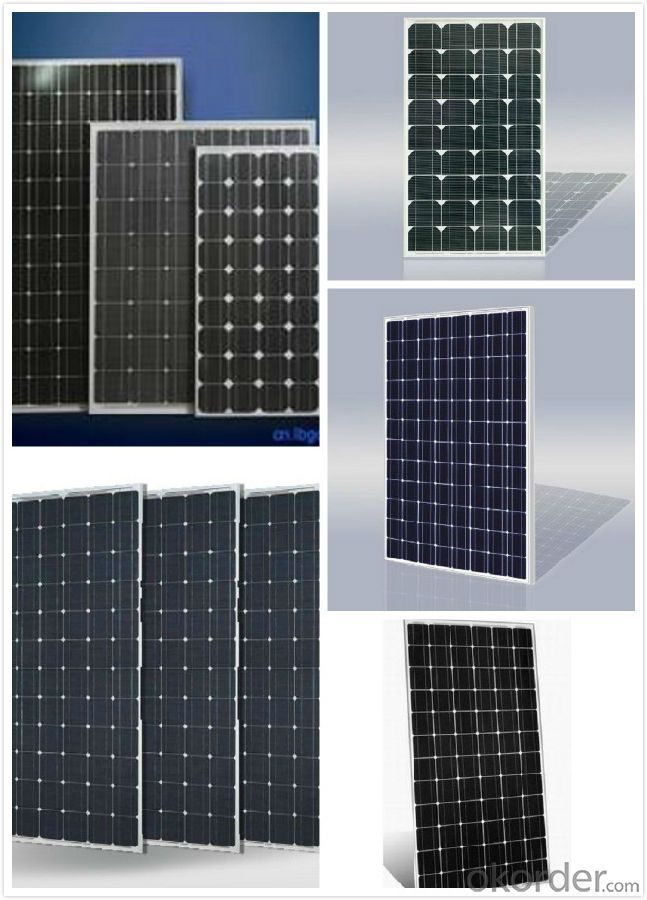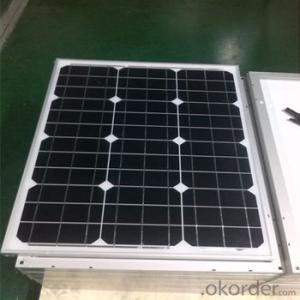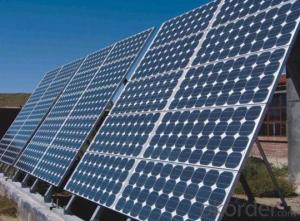SOLAR PANELS,SOLAR PANEL MONO 260w ,SOLAR MODULE FOR SALE
- Loading Port:
- Shanghai
- Payment Terms:
- TT OR LC
- Min Order Qty:
- 2600 watt
- Supply Capability:
- 26000 watt/month
OKorder Service Pledge
OKorder Financial Service
You Might Also Like
Item specifice
We now provide
• Monocrystalline Solar Panel
• Polycrystalline Solar Panel( multicrystalline silicon Solar Panel)
Features of our products:
• High conversion efficiency mono/poly-crystalline amorphous silicon solar cells
• Modules incorporate high performance bypass diodes to minimize the power drop caused by shading
• High transmittance, low-iron tempered glass
• High performance EVA encapsulant to prevent destroying and water.
• AI frame: without screw, corner connection. 8 holes on the frame can be installed easily
• Good performance of preventing from atrocious weather such as wind and hails
Limited Product Warranty
Under normal application, installation, use and service conditions, if MODULES fail to conform to this limited product warranty due to defects in material or workmanship, then for a period ending 12 years from date of sale as shown in the invoice or Contract issued by CNBM SOLAR. CNBM SOLAR will, at its option, either repair or replace or refund the purchase price as paid by the client for these defective MODULES. The repair or replacement or refund remedy shall be the sole and exclusive remedy provided under the “Limited Product Warranty” and shall not extend beyond the 12 years period set forth herein. It will be performed directly to the direct client only. This “Limited Product Warranty” does not warrant a specific power output, which shall be exclusively covered under “Limited Peak Power Warranty” as

Product Description:
This installation Manual contains essential information for the electrical and mechanical installation that your must know before installing CUSTOMER PV modules. This also contains safety information you need to be familiar with .All the information described in this manual are the intellectual property of CNBM and based on the technologies and experiences that have been acquired and accumulated in the long history of CUSTOMER. This document does not constitute a warranty, expressed or implied.
CUSTOMER does not assume responsibility and expressly disclaims liability for loss, damage, or expense arising out of in anyway connected with installation, operation, use or maintenance of the PV modules. No responsibility is assumed by CUSTOMER for any infringement of patents or other rights of third parties that may result from use of PV module.
CUSTOMER reserves the right to make changes to the product, specifications or installation manual without prior notice.
Solar panel working process
In addition to being the ultimate source of all life on earth, the sun is an infinitely renewable, completely pollution-free source of electricity. Instead of burning fossil fuels dug up from the ground in a big power plant – a very 19th century, industrial age approach, when you think about it – solar panels convert sunlight directly into electricity, with no harmful emissions.
The basic unit of a solar panel is a solar cell, which usually consists of one or two layers of silicon-based semiconductor wafers. When struck by the photons in sunlight, the solar cell generates an electrical charge due to the "photovoltaic effect" – which is a pretty good name, since it produces voltage from photons. The flow of these electrons moves in a steady electrical current from one side of the cell to the other.
Dozens of these PV cells are packaged together into solar modules, which in turn are packaged into solar panels that are mounted on a rooftop and arranged to maximize their hours of exposure to direct sunlight. Because the electricity generated by all those solar cells is direct current (DC), it is then sent to an inverter that transforms the power into the same alternating current (AC) used by the appliances in your home and the local utility electricity distribution grid. Increasingly, these inverters are getting "smart," providing data monitoring for solar installation performance and other grid integration services.
FAQ
We have organized several common questions for our clients,may help you sincerely:
③Can you provide the peripheral products of the solar panels, such as the battery, controller, and inverter? If so, can you tell me how do they match each other?
Yes, we can, we have two companies for solar region, one is CNBM International, the other is CNBM engineering Co.
We can provide you not only the solar module but also the off grid solar system, we can also provide you service with on grid plant.
④What is your warranty system?
Our product performance guarantees for 25 years
• 12 years guarantee for workmanship
• Timeliness of delivery
• Quality Products certified (TÜV, UL, CE, ISO)
⑤How do you pack your products?
We have rich experience on how to pack the panels to make sure the safety on shipment when it arrives at the destination.
- Q:Can solar panels be damaged by birds or rodents?
- Yes, solar panels can be damaged by birds and rodents. Birds may nest, perch, or peck at the panels, causing cracks or scratches on the surface. Rodents, on the other hand, can chew through the wiring or insulation, leading to electrical issues. Regular maintenance and bird deterrents can help minimize the risk of damage.
- Q:How do solar panels affect the property's operating costs?
- Solar panels can significantly reduce a property's operating costs by generating clean and renewable electricity. By harnessing sunlight, solar panels can power various appliances and systems, reducing or even eliminating the need to rely on expensive grid electricity. This can lead to substantial savings on utility bills, making solar panels a financially sound investment for property owners.
- Q:I need a list of worldwide solar panel manufactures from china, US, Spain, Germany, Japan etc...Can any one direct ne to such place?I rather it will also contain comparison of parameters like efficiacy, quality etc and to be divedied by country of manufacturing.Thank you
- Actually Ofir, it is much easier and less expensive than you might believe. What you need is a magazine, like, Solar Today. There is only one that I am familiar with that gets into the nuts and bolts of solar panel manufacturers, installation, and other types of renewable energy. It's called, Home Power Magazine. We have a home that has been powered by the wind and sun for the last 0 years or so, and most of our initial information came from Home Power, and afterward, from many of the sources that they have in their articles. Every few issures, they take an item connected to renewable energy, such as an inverter, wind turbine, water turbine, or solar panel, and list all the different models that are available. They are broken down by manufacturer, and include specifications like power output, range of voltages, efficiency, materials, and even where they are manufactured. If you subscribe online for one year, the cost is around $25 USD, you will have access to all the previous issues that are archived on their website. You can use their search engine to locate an article listing all the solar panels, they did one a year or so ago with all the information you are looking for. Despite what you might be hearing, solar power usage is growing at an incredible rate. In the US alone, there are over 00,000 homes and businesses operating some level of solar power right now, that's good news. As far as different countries using different requirements, most all of the manufacturers today are selling their products to most countries worldwide, they are designed to meet requirements for almost anyplace you might use them. Check the magazine out today, you might learn more than you were originally looking for. I will include their link below, and some other good sources for information. You can google any one of them to find their website. Good luck, and take care...Rudydoo
- Q:I want to be more green and if I get the panels will I still have a regular electric bill?
- The most cost-effective solution, which the vast majority of new installs use today, is solar alongside the regular power company. That way, you need no batteries, and if the solar array isn't producing enough at any given time, you draw from the electric company. When the array is producing more than you need, instead of just throwing that power away, the power company buys it (usually). In short, yes, you will still have an electric bill, but a smaller one. On our house, the electric bill was a little less than $5 a month, with an end-of-year settlement of an additional $2. How much does it cost? Unfortunately, that's like asking how much personal transportation costs. Some people need a van to transport the kids to soccer, some may get by with a motorcycle, others may need only a bicycle. The best thing is to contact a professional installer to get a quote based on your location and electrical usage. Solar electric does not make financial sense in all areas. Our array cost $2,000 but don't use that as a guide. Yours might be 0 times that, or half that, depending on your area and needs.
- Q:Are there any limitations to the lifespan of solar panels?
- Yes, there are limitations to the lifespan of solar panels. Over time, solar panels experience a gradual decrease in efficiency due to factors like exposure to environmental elements, wear and tear, and potential manufacturing defects. Additionally, the materials used in solar panels may degrade over time, which can affect their performance and overall lifespan. However, with proper maintenance and regular inspections, solar panels can typically last for 25 to 30 years or even longer.
- Q:Can solar panels be used in areas with high levels of electromagnetic radiation?
- Yes, solar panels can be used in areas with high levels of electromagnetic radiation. While electromagnetic radiation can potentially interfere with the efficient functioning of solar panels, proper shielding and design considerations can mitigate such effects. Additionally, solar panels themselves do not emit electromagnetic radiation, making them suitable for deployment in areas with high levels of such radiation.
- Q:If you were to shine, for example, heat lamps onto the solar panel along with the sun, will the solar panel eventually not work? Or will they produce more light as long as more light is directed onto them.
- A photovoltaic cell will only be 'sensitive' to a band of radiation...and would probably not even 'see' the energy from a heat lamp. So, no, the solar panel would not be 'overworked' if somehow you could put 2 or 3 suns in the sky at once. It would simply ignore, so to speak, the photons that it didn't need. But, the heat from the heat lamp, or the extra photons, would eventually heat up the glass and the plastic the thing is made of, and it would fail prematurely.
- Q:Can solar panels be used in areas with high levels of pollution from transportation?
- Yes, solar panels can be used in areas with high levels of pollution from transportation. While pollution may have some impact on the efficiency of solar panels, they can still generate electricity even in polluted environments. However, regular maintenance and cleaning may be required to ensure optimal performance and prevent any potential buildup of pollutants on the panel surface.
- Q:A few months ago my dad said something about getting solar panels, and how green they were. I was just wondering if there were any companies that sold them and if they would actually make a big difference.
- Yes there are companies that sell solar panels, many of them specialize in solar, a simple google search with your state or city name and the word solar should get you many results. There are actually two kinds of solar panels that get installed on homes, one kind creates electricity, the other heats up water. Depending on how large a system you installed, you could have all of your electricity or hot water powered by solar, which would mean you'd use less nonrenewable resources like coal, oil, or natural gas. The other difference the solar panels would make would be in your electric or gas bill, that number would go down right away, but you'd have to wait a few years before the money you save there would cover the cost of buying the panels, the number of years depends on your state, and the size of your system. Starting in January there will be a 30% federal tax credit, that would mean savings for every installation in the US. Also a lot of states now have a rebate program, which means the system is even less expensive.
- Q:How do solar panels affect roof aesthetics?
- Solar panels can have both positive and negative impacts on roof aesthetics. On one hand, solar panels can enhance the visual appeal of a roof by adding a sleek and modern look. They can also make a statement about a homeowner's commitment to renewable energy. However, some people may find solar panels to be visually intrusive and believe that they disrupt the overall harmony and symmetry of a roof. Ultimately, the impact on roof aesthetics depends on individual preferences and the design of the solar panel installation.
1. Manufacturer Overview |
|
|---|---|
| Location | |
| Year Established | |
| Annual Output Value | |
| Main Markets | |
| Company Certifications | |
2. Manufacturer Certificates |
|
|---|---|
| a) Certification Name | |
| Range | |
| Reference | |
| Validity Period | |
3. Manufacturer Capability |
|
|---|---|
| a)Trade Capacity | |
| Nearest Port | |
| Export Percentage | |
| No.of Employees in Trade Department | |
| Language Spoken: | |
| b)Factory Information | |
| Factory Size: | |
| No. of Production Lines | |
| Contract Manufacturing | |
| Product Price Range | |
Send your message to us
SOLAR PANELS,SOLAR PANEL MONO 260w ,SOLAR MODULE FOR SALE
- Loading Port:
- Shanghai
- Payment Terms:
- TT OR LC
- Min Order Qty:
- 2600 watt
- Supply Capability:
- 26000 watt/month
OKorder Service Pledge
OKorder Financial Service
Similar products
New products
Hot products
Hot Searches
Related keywords





























